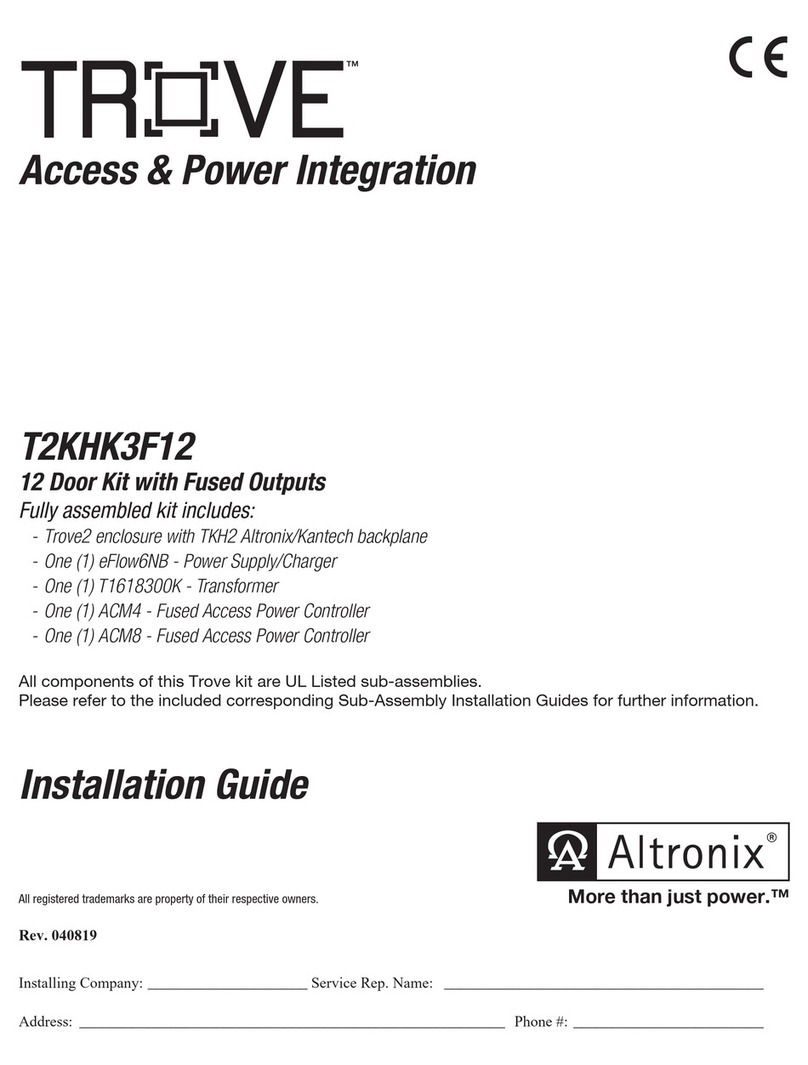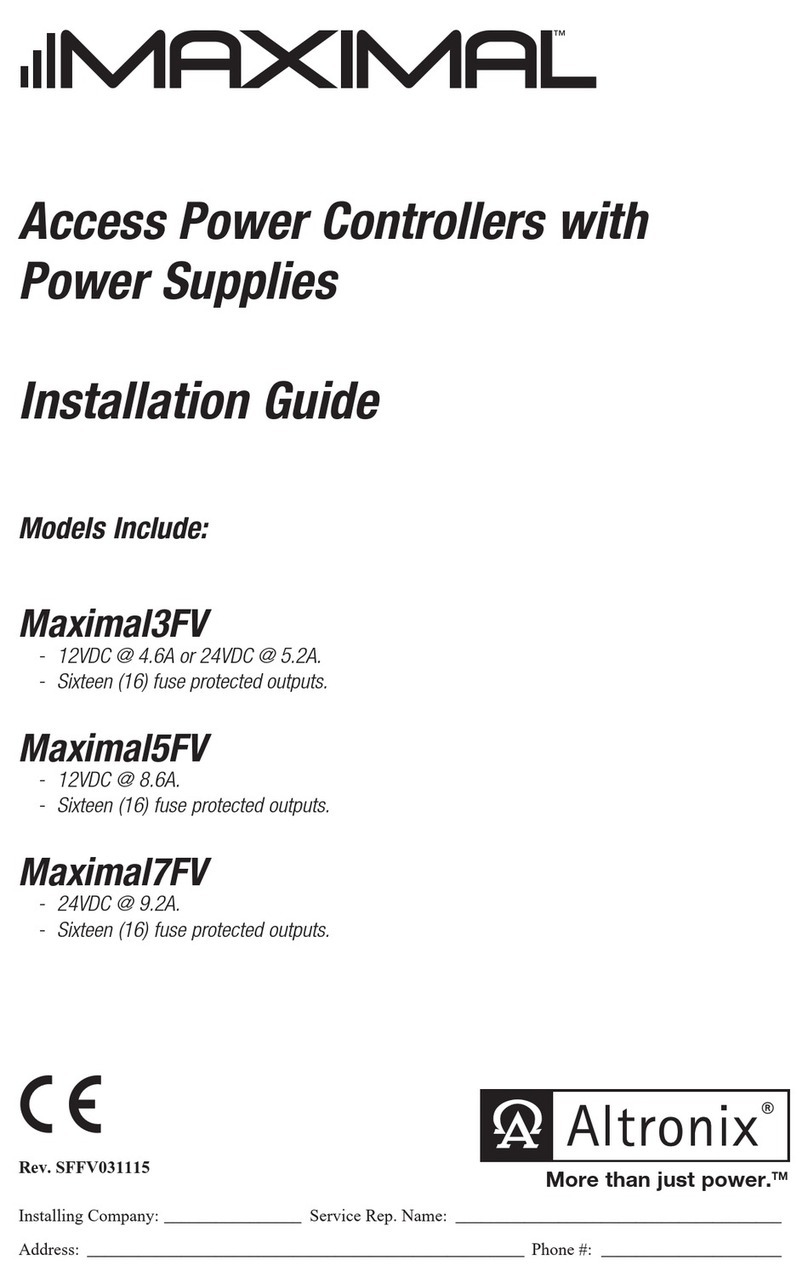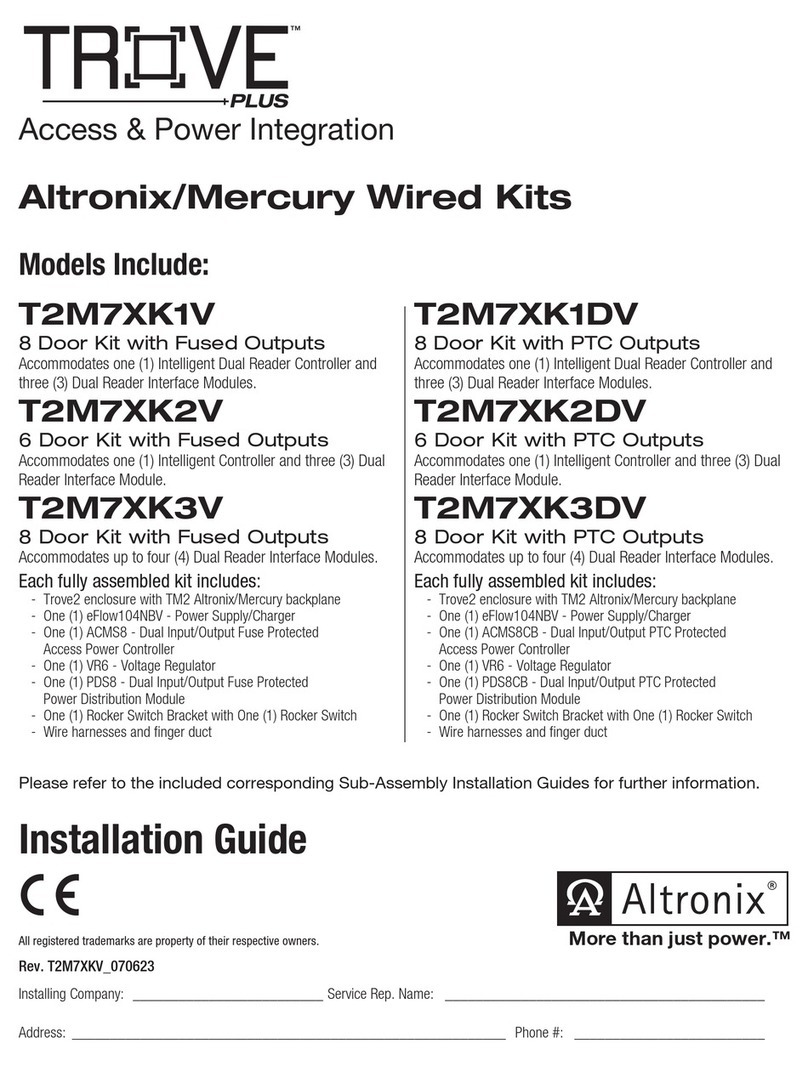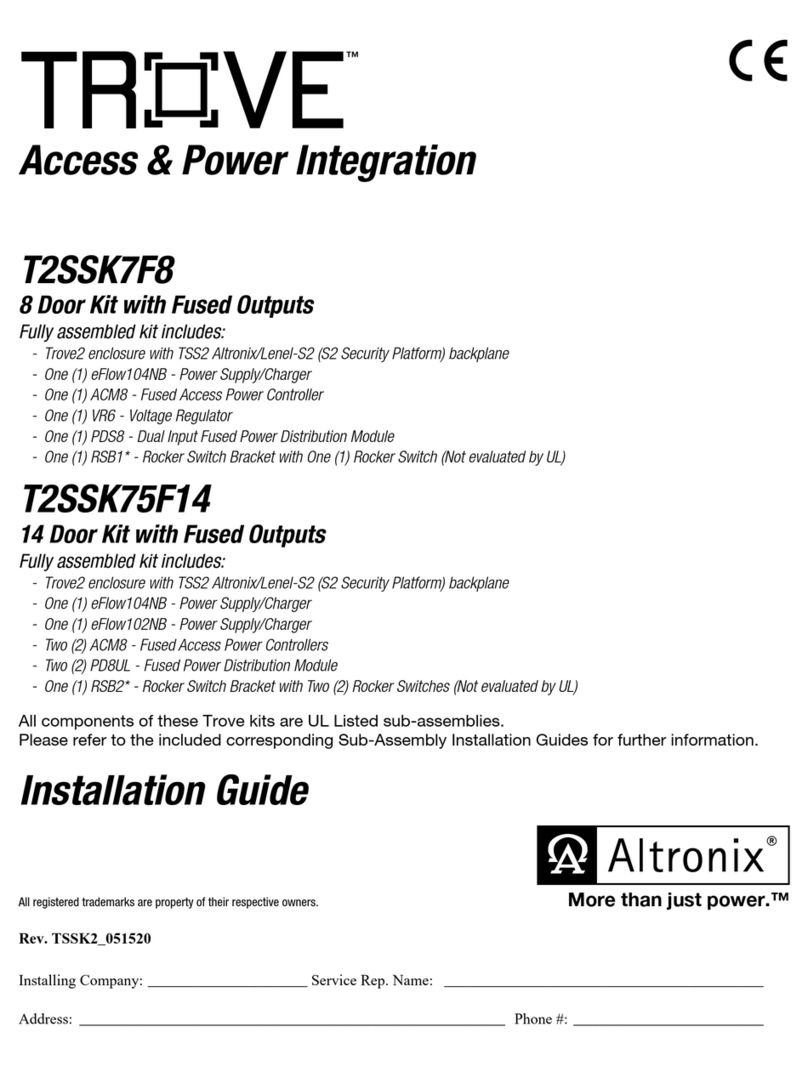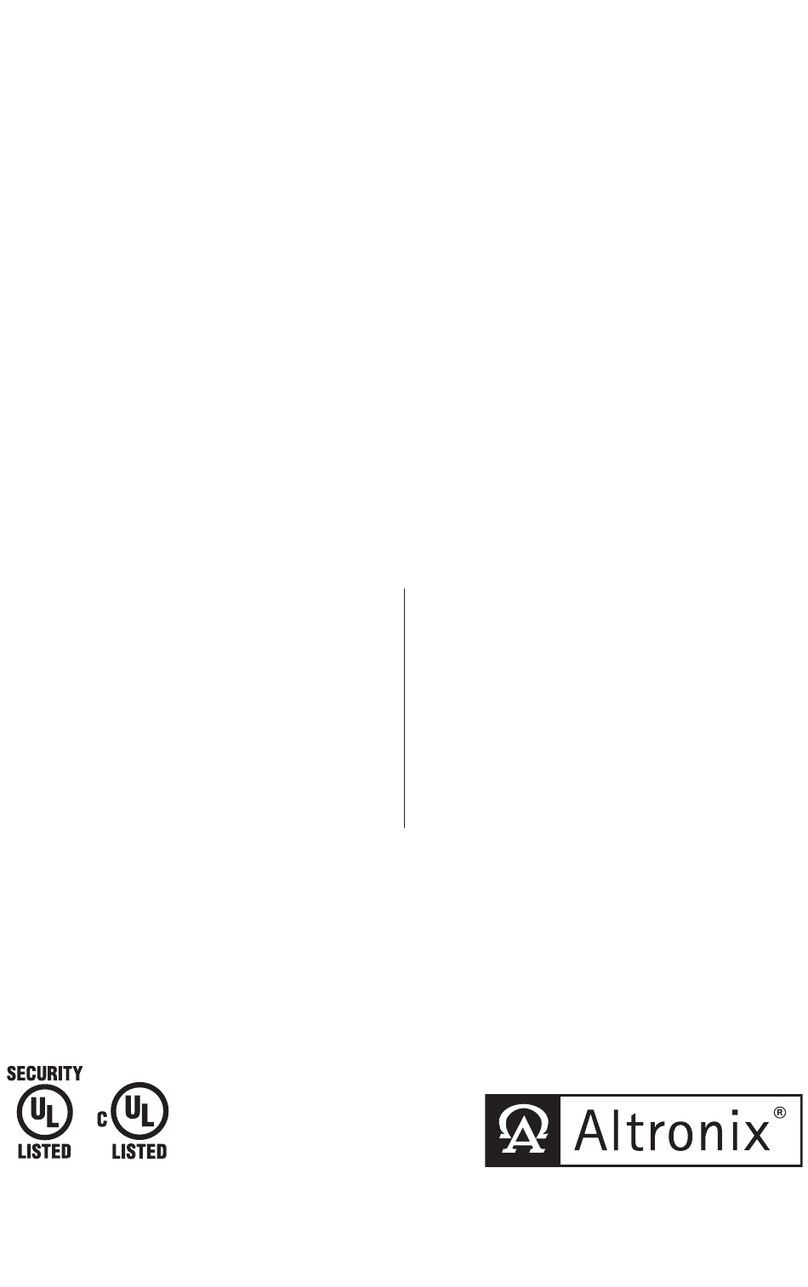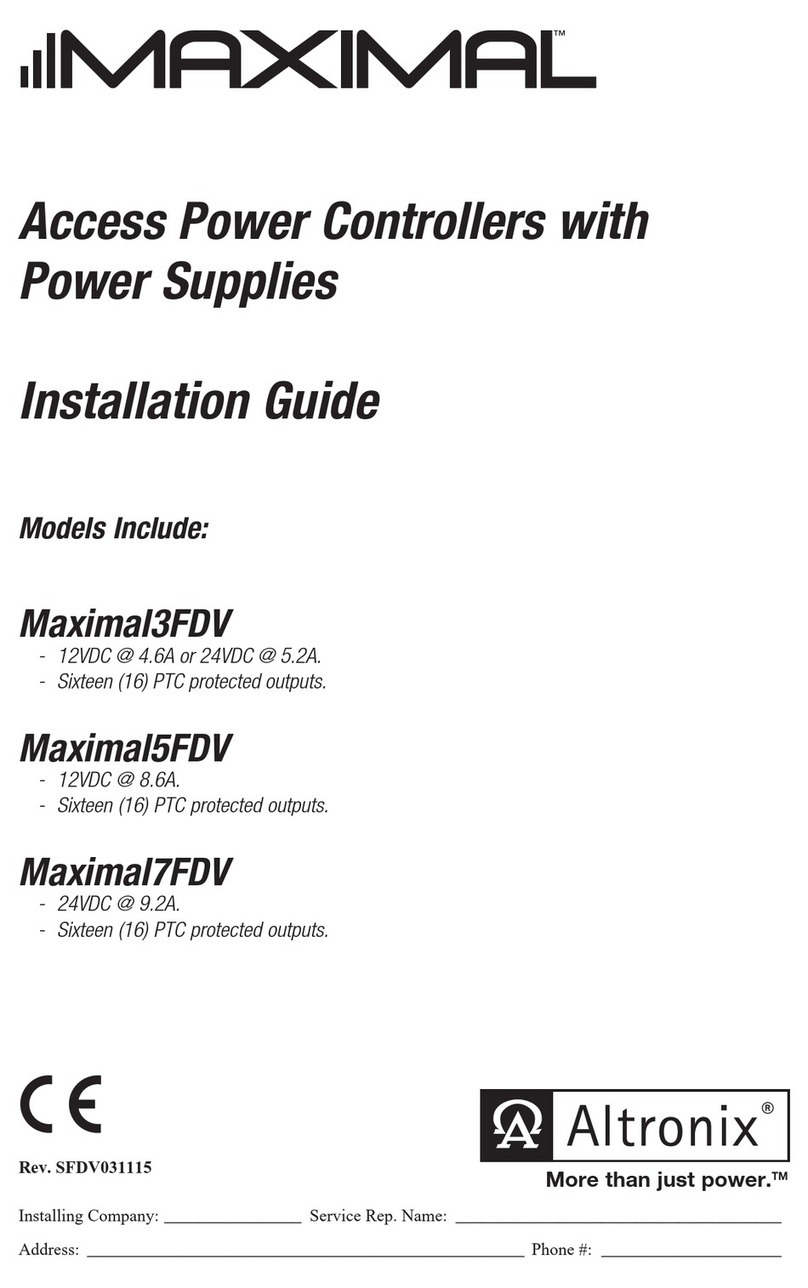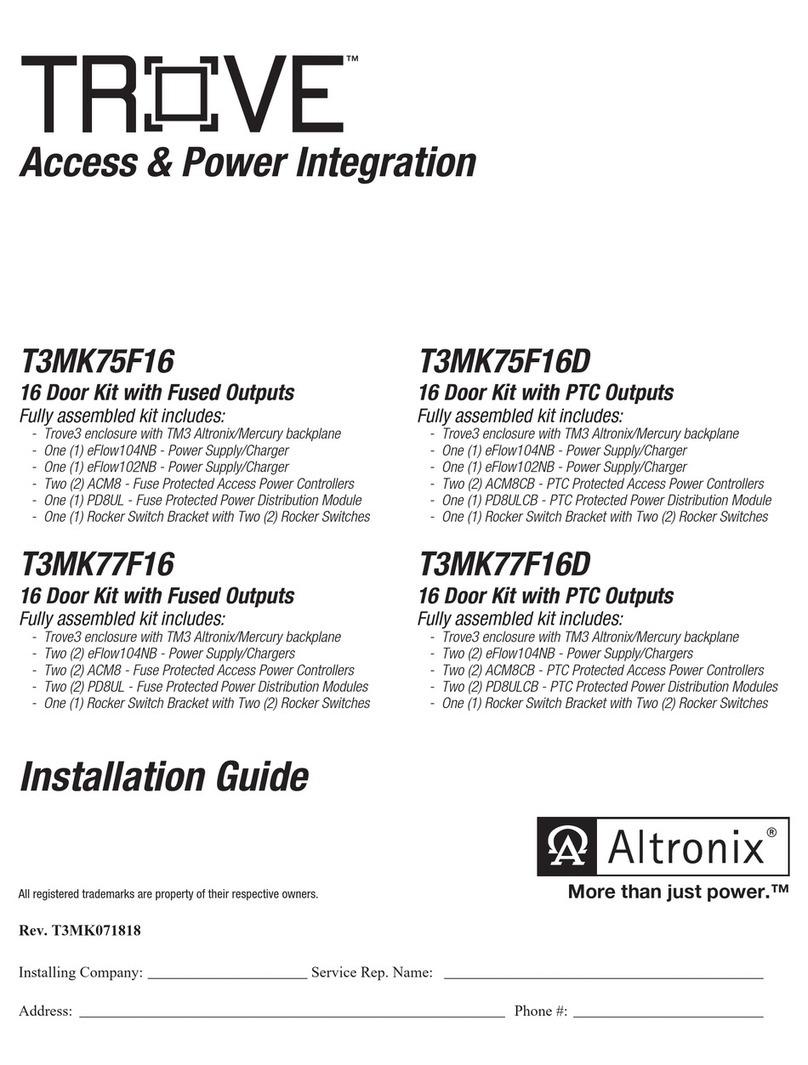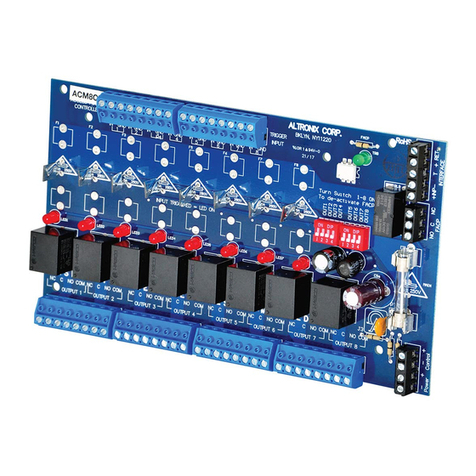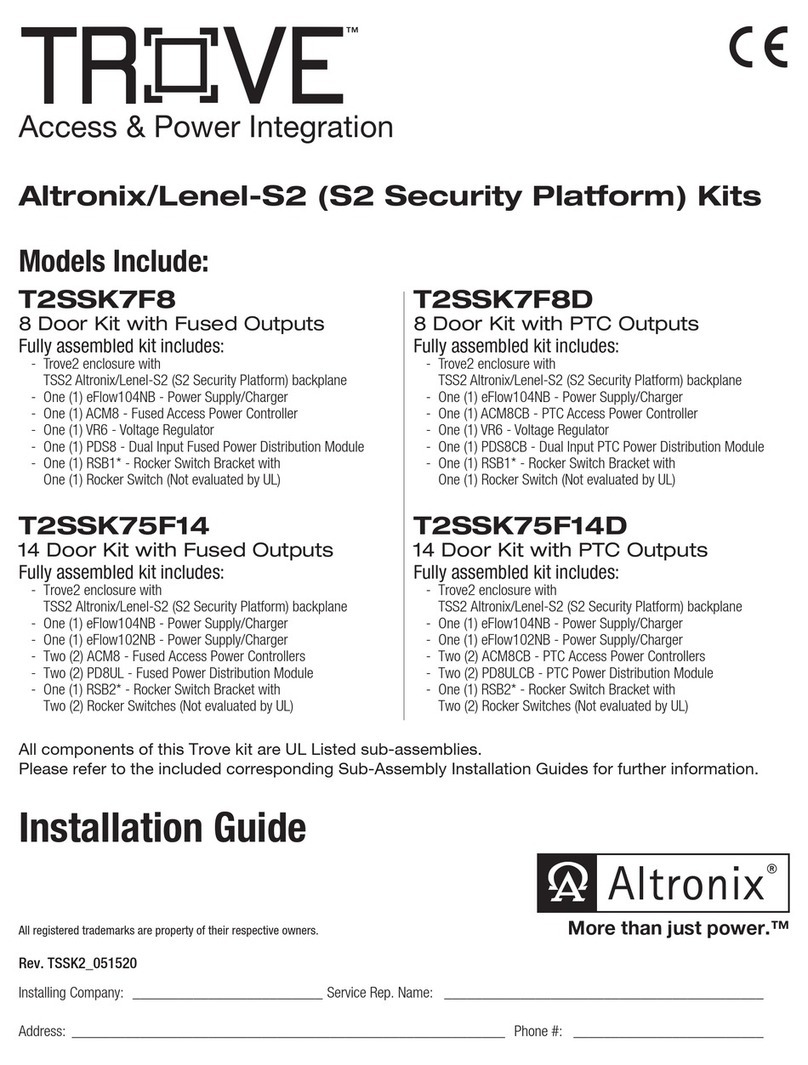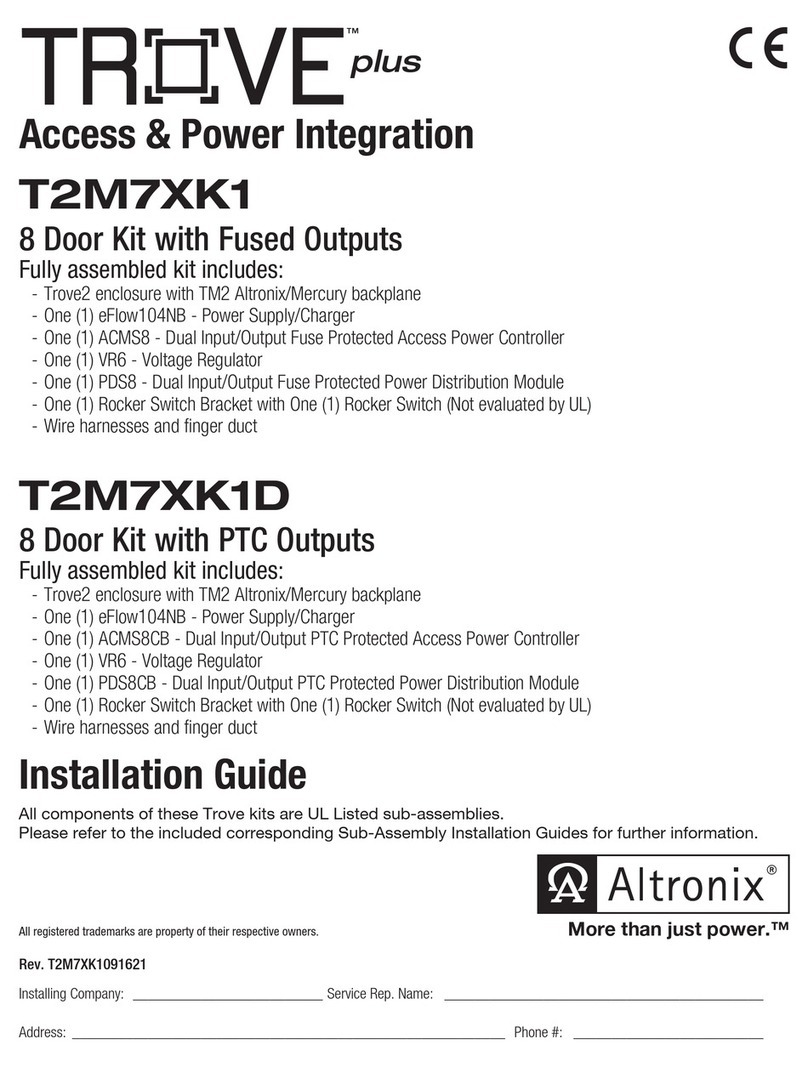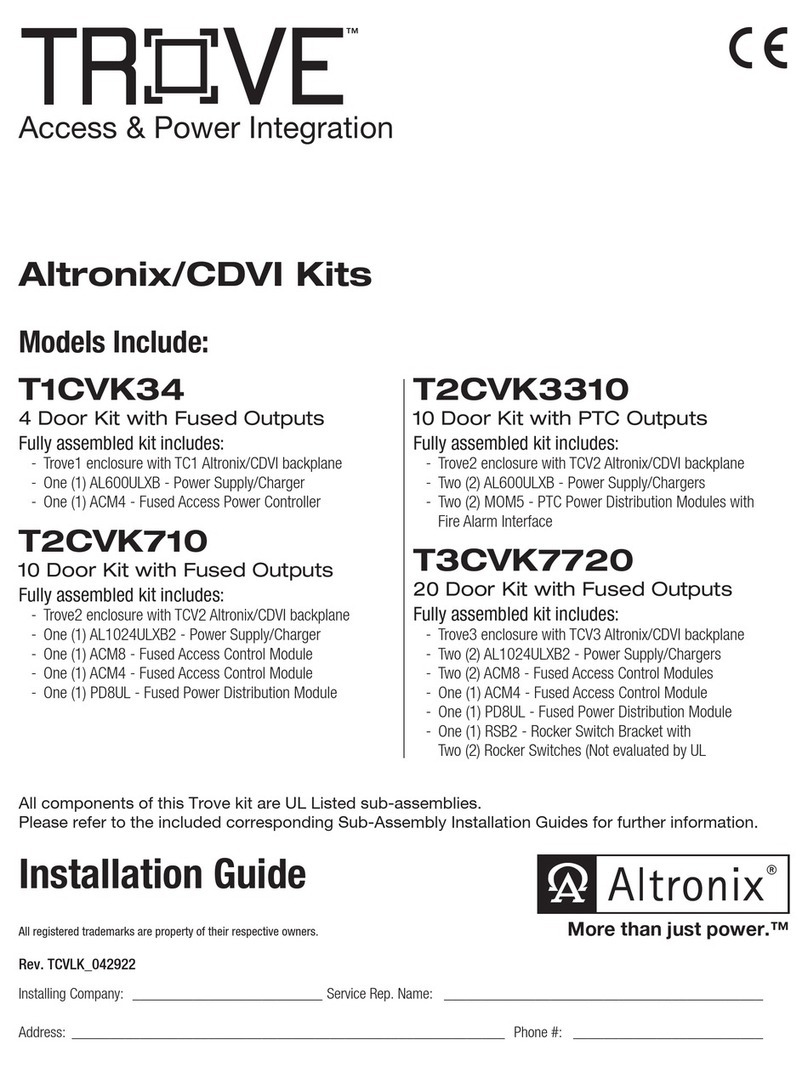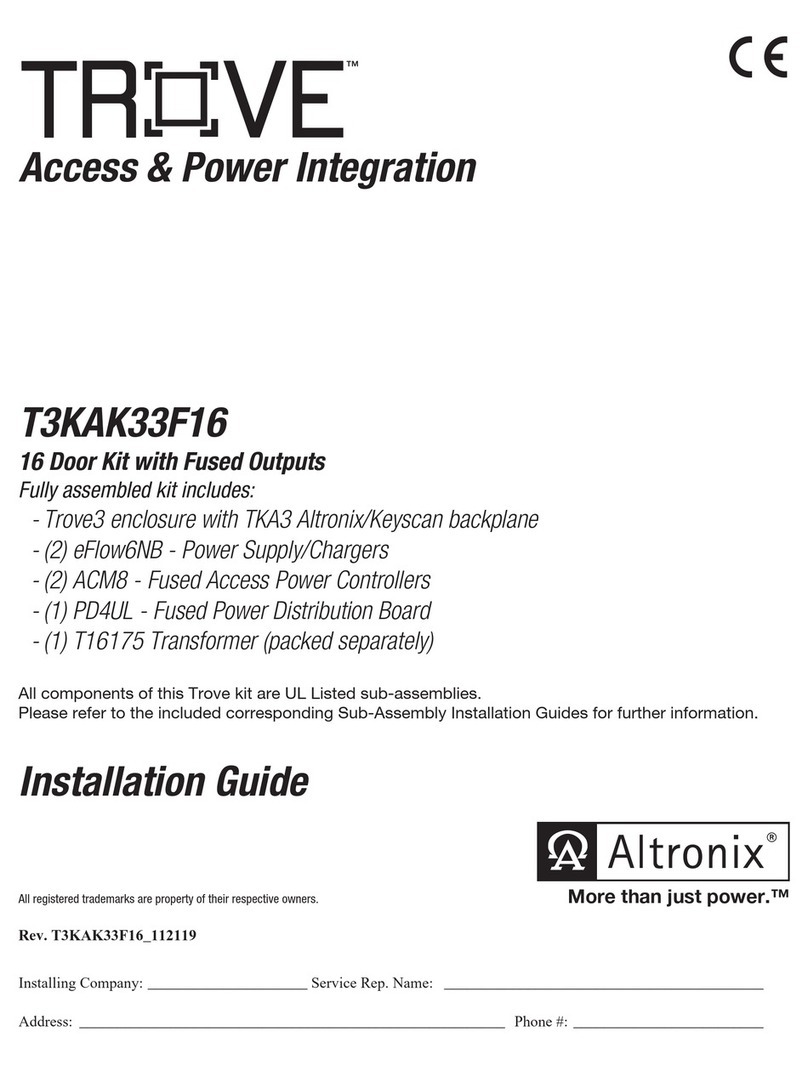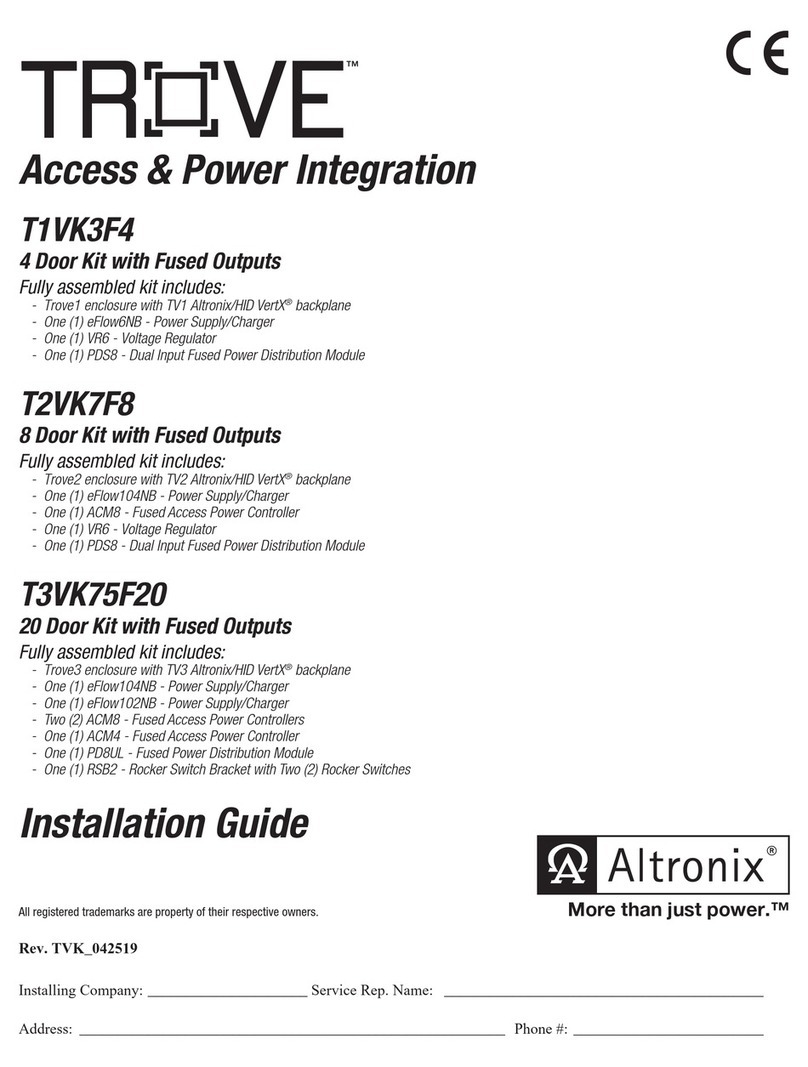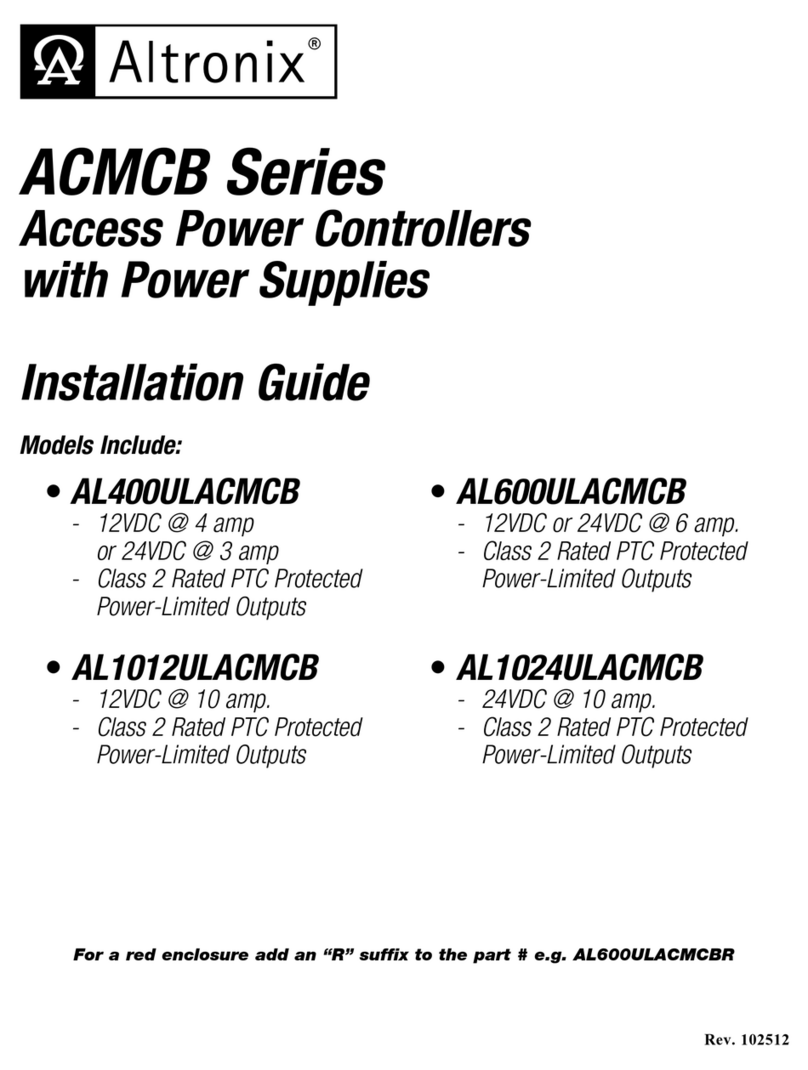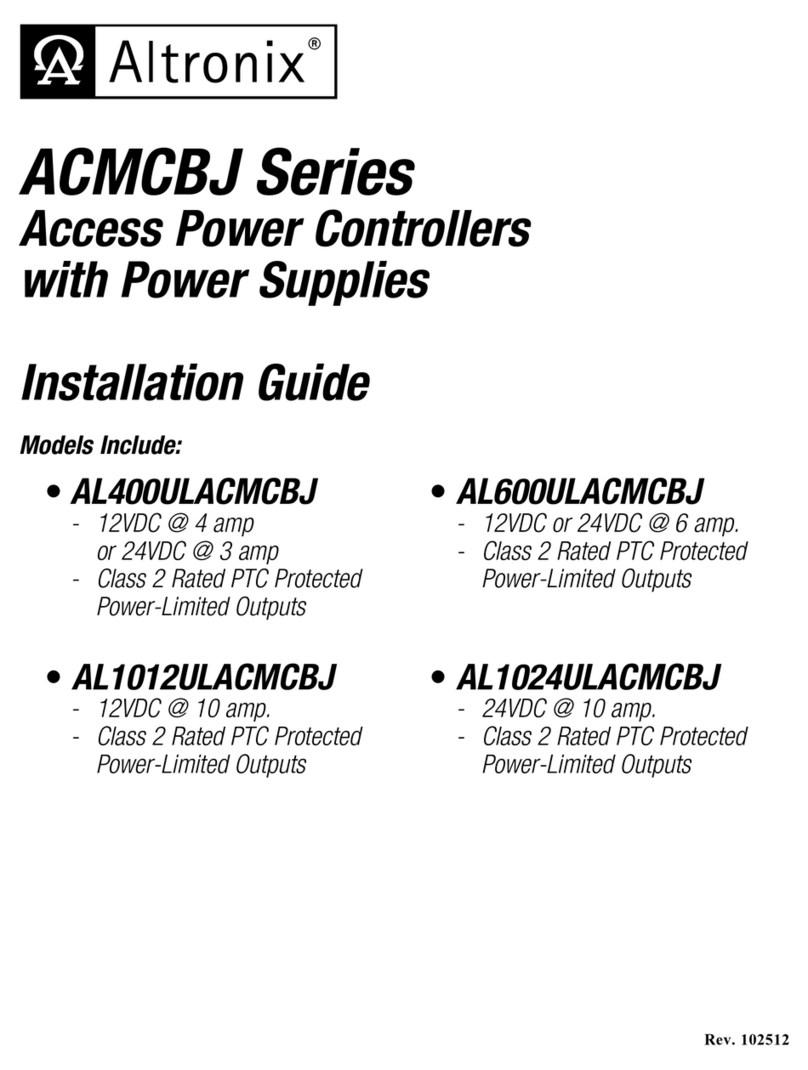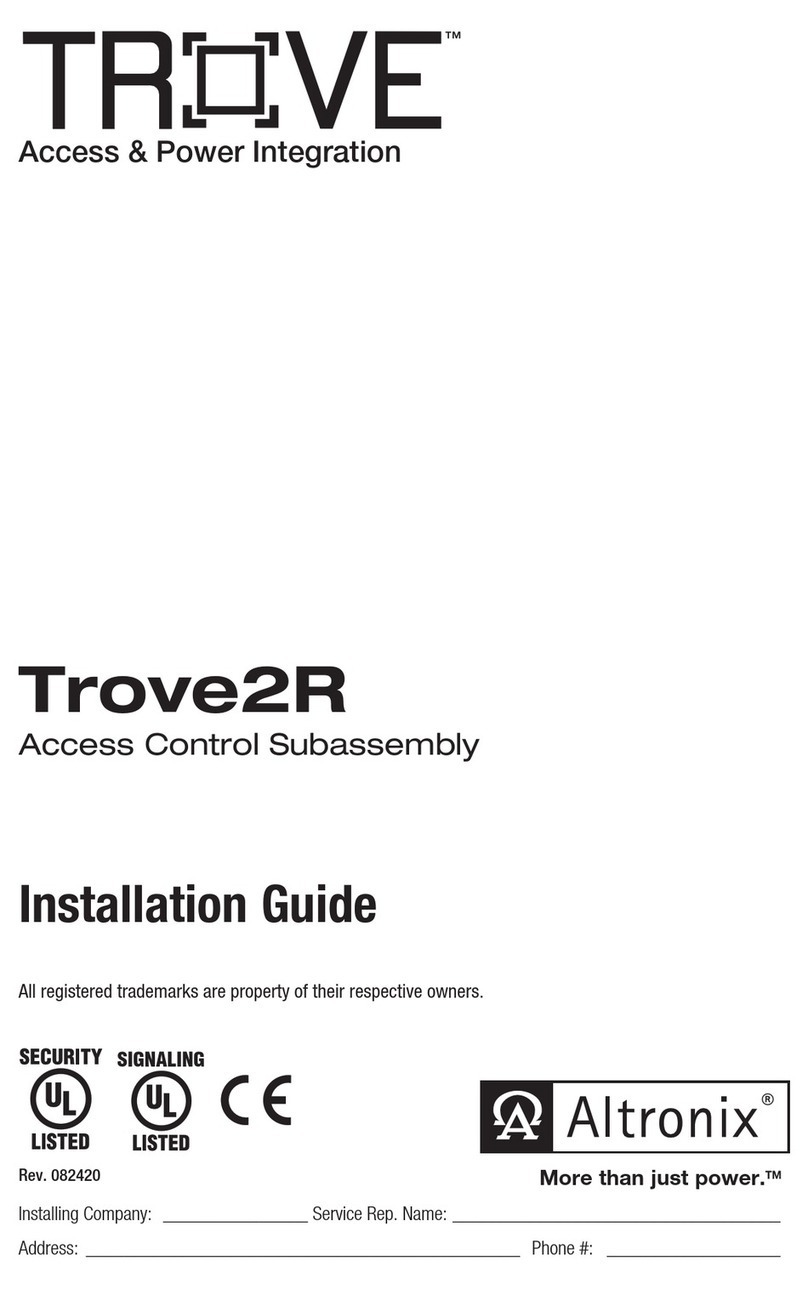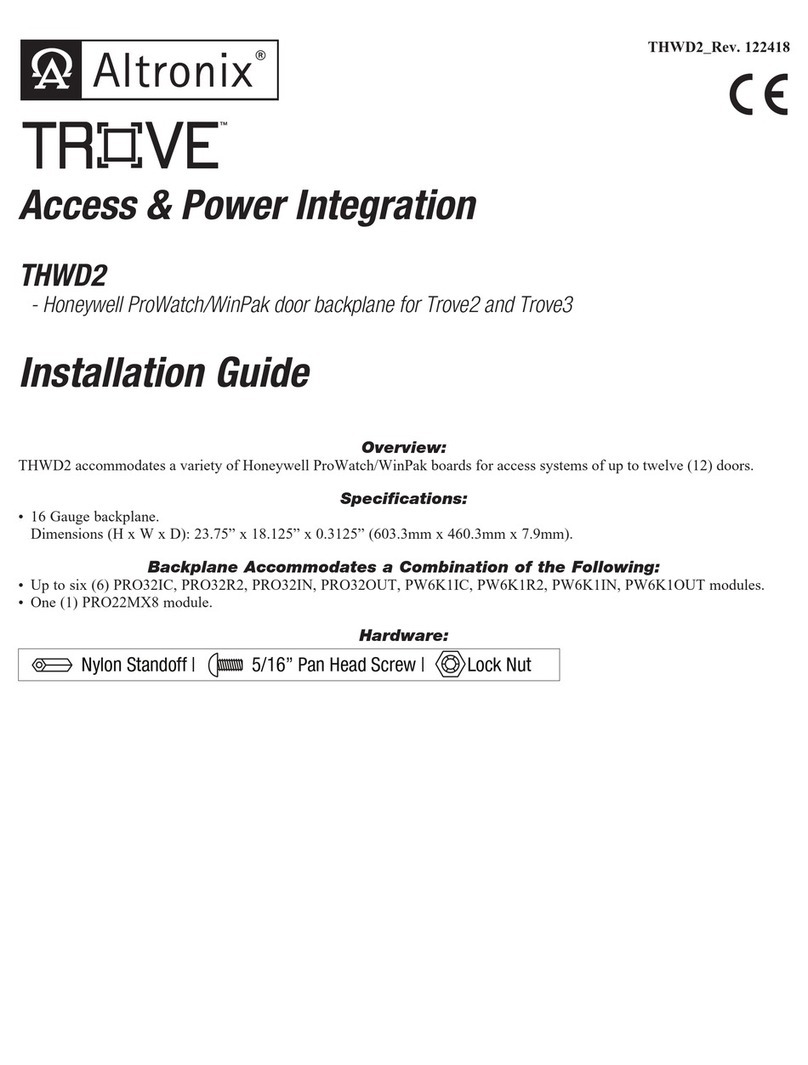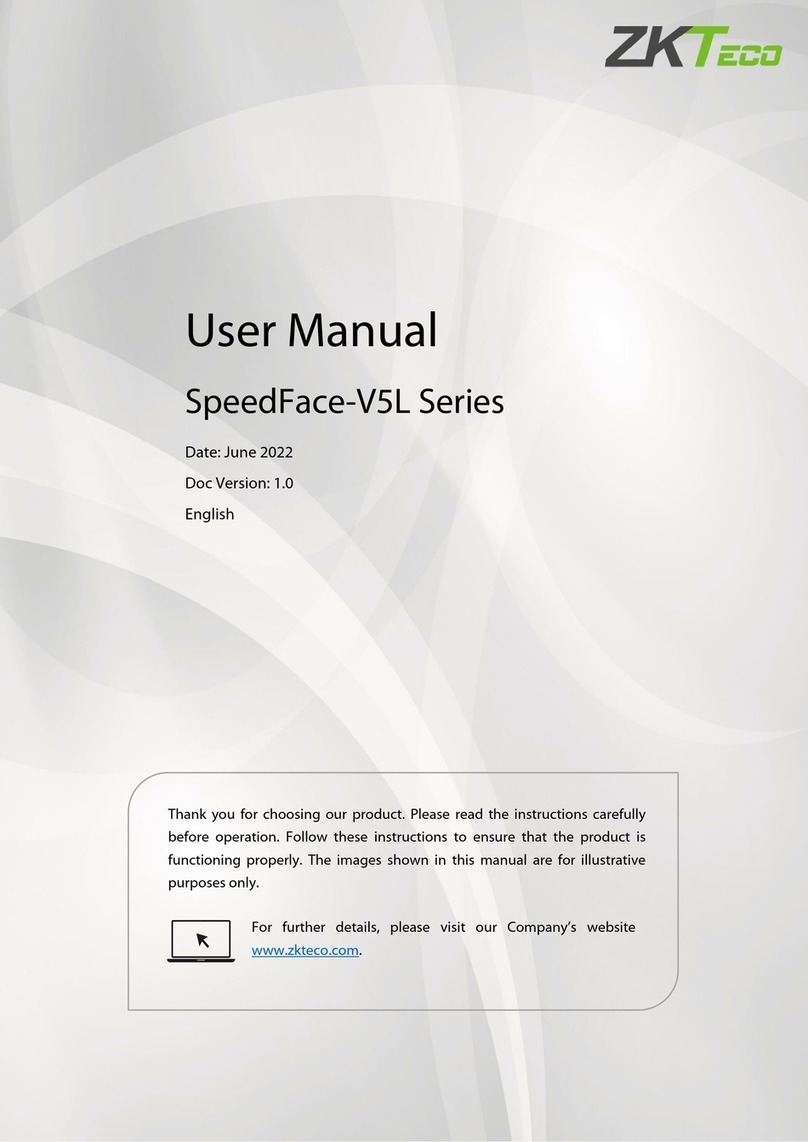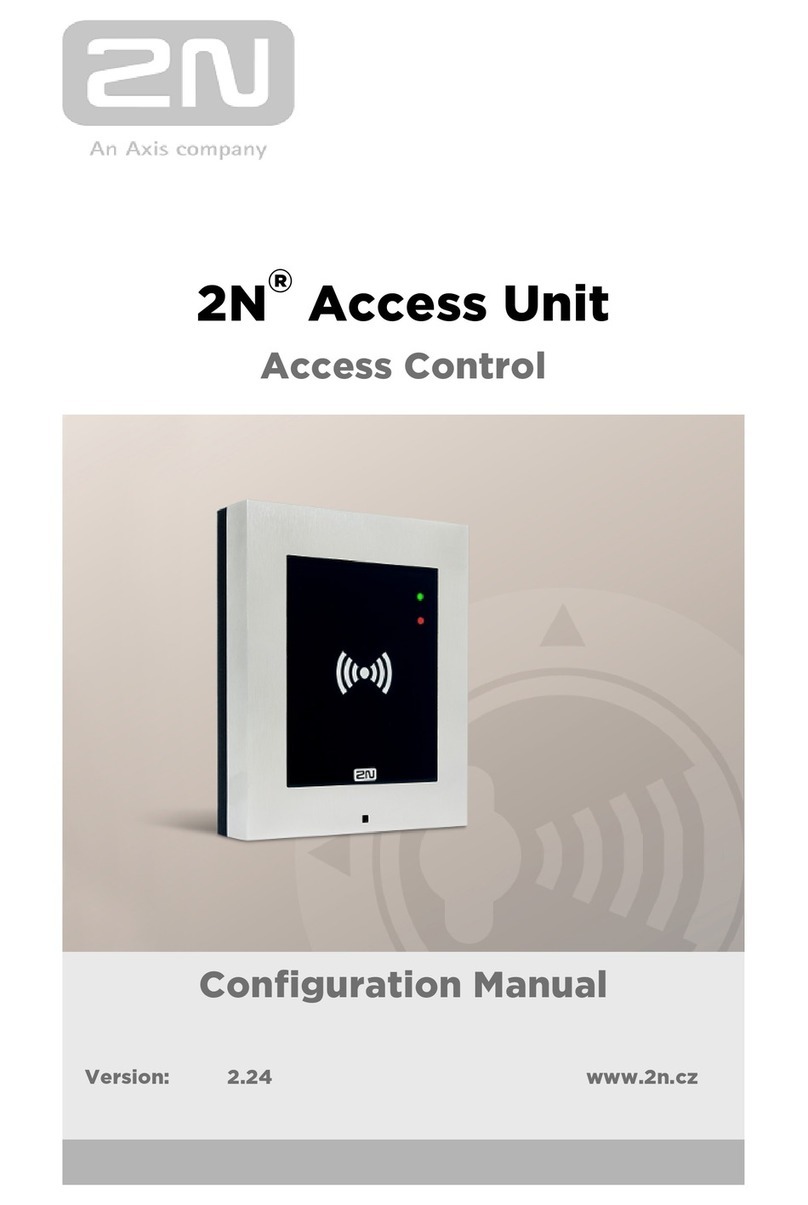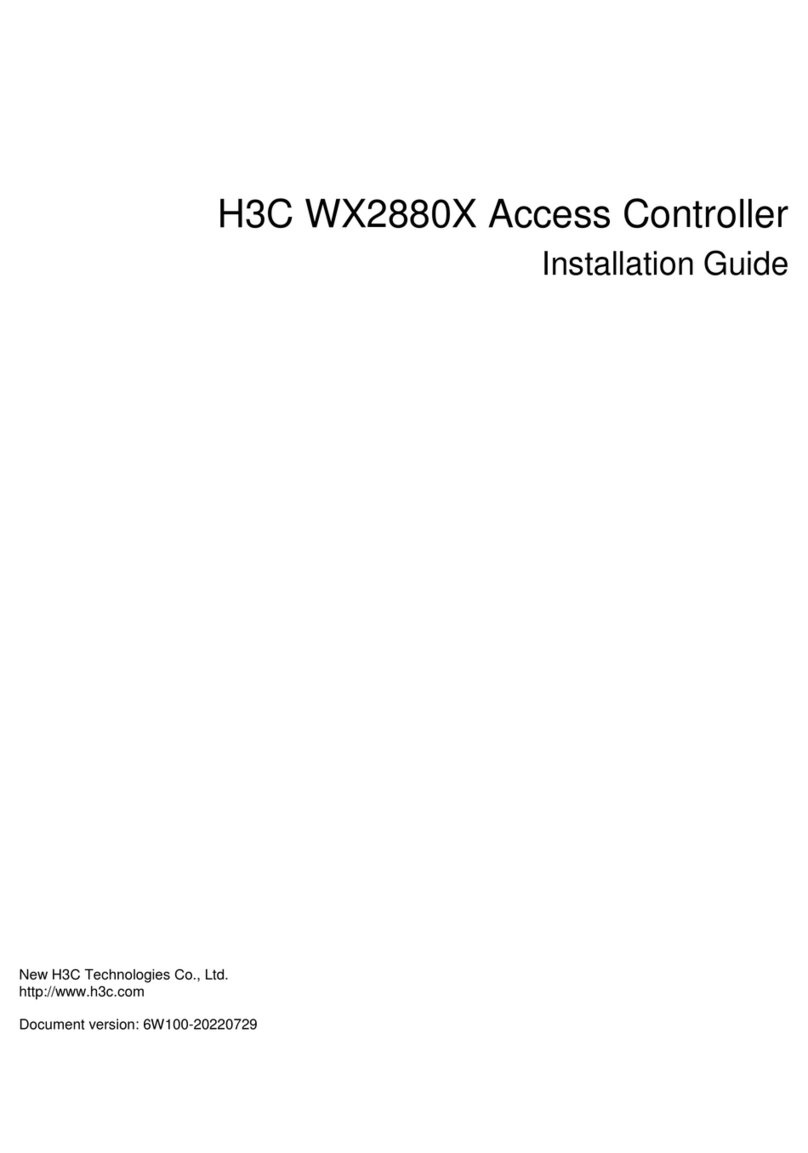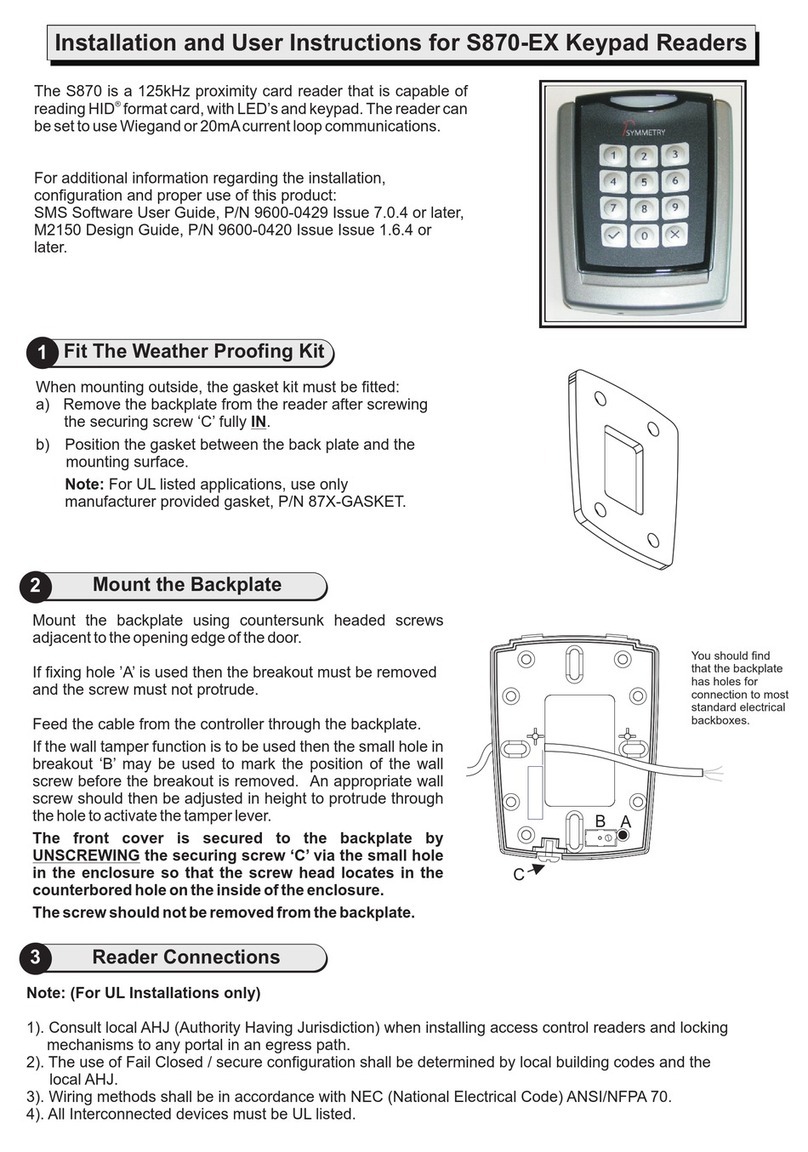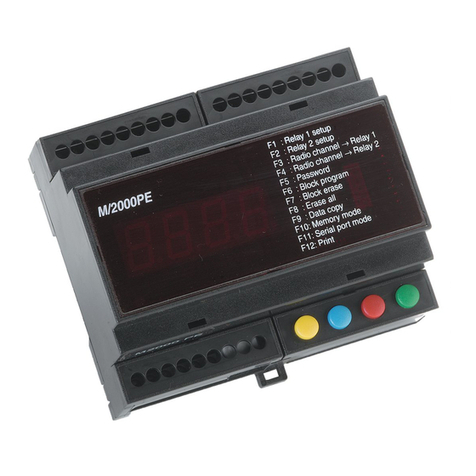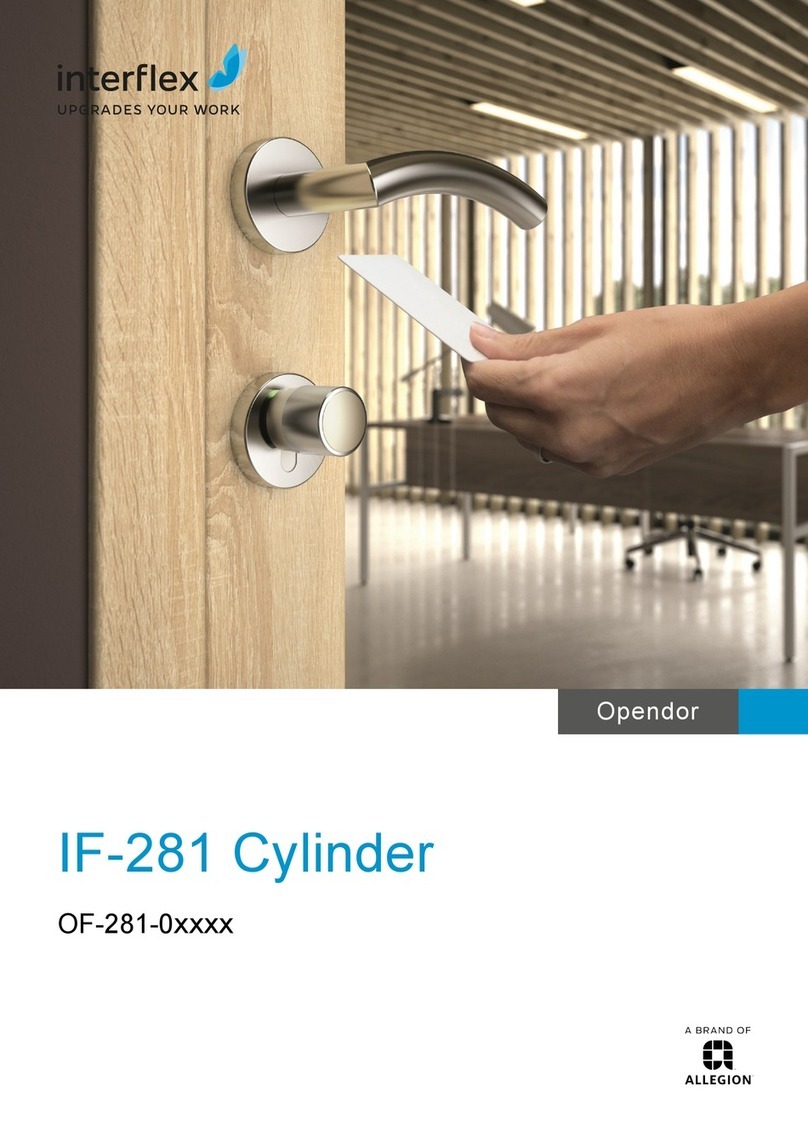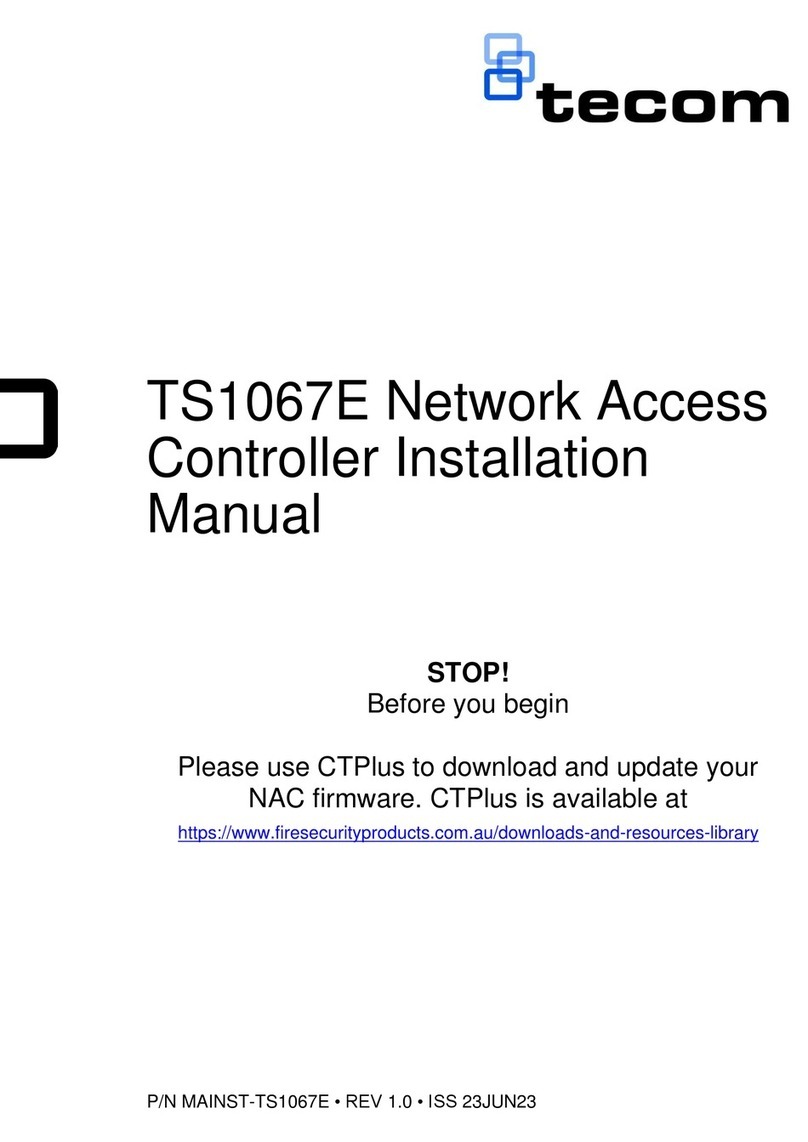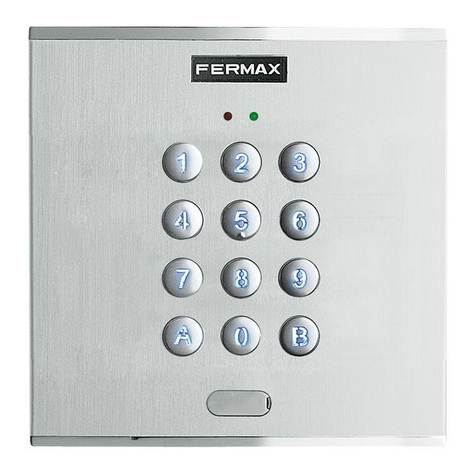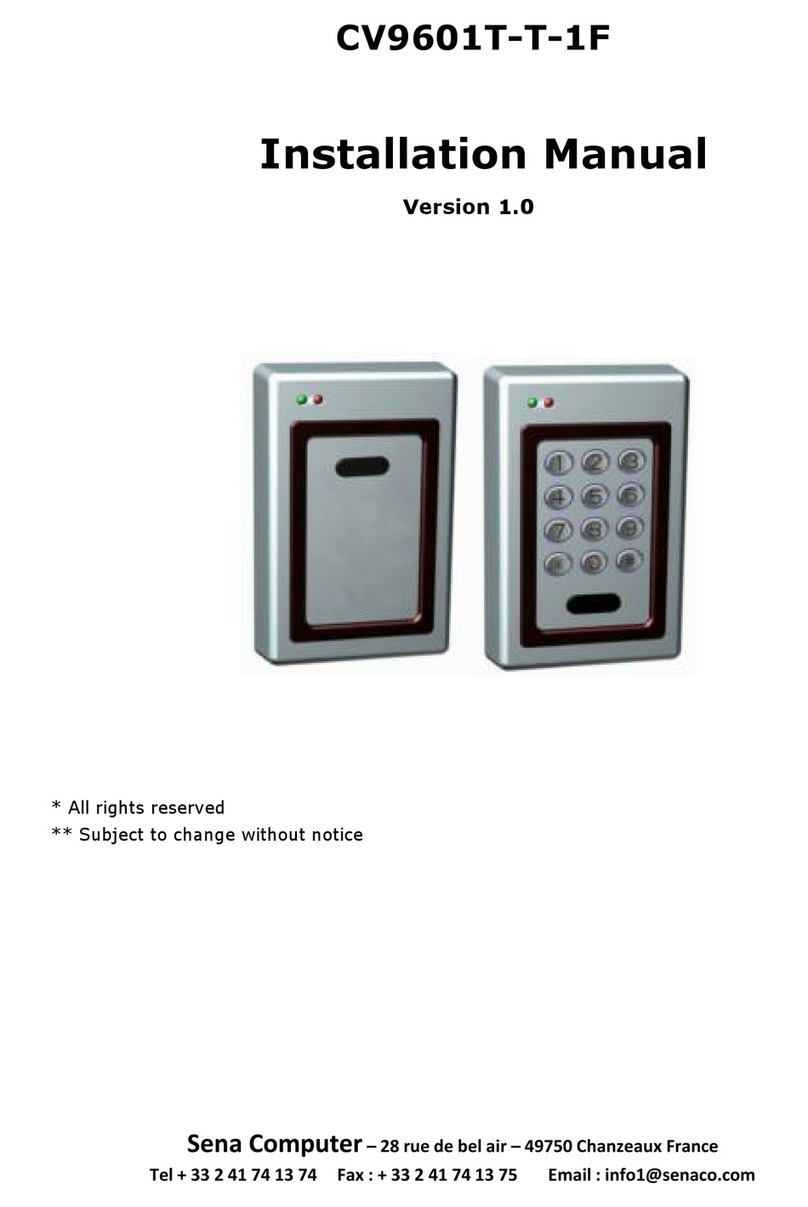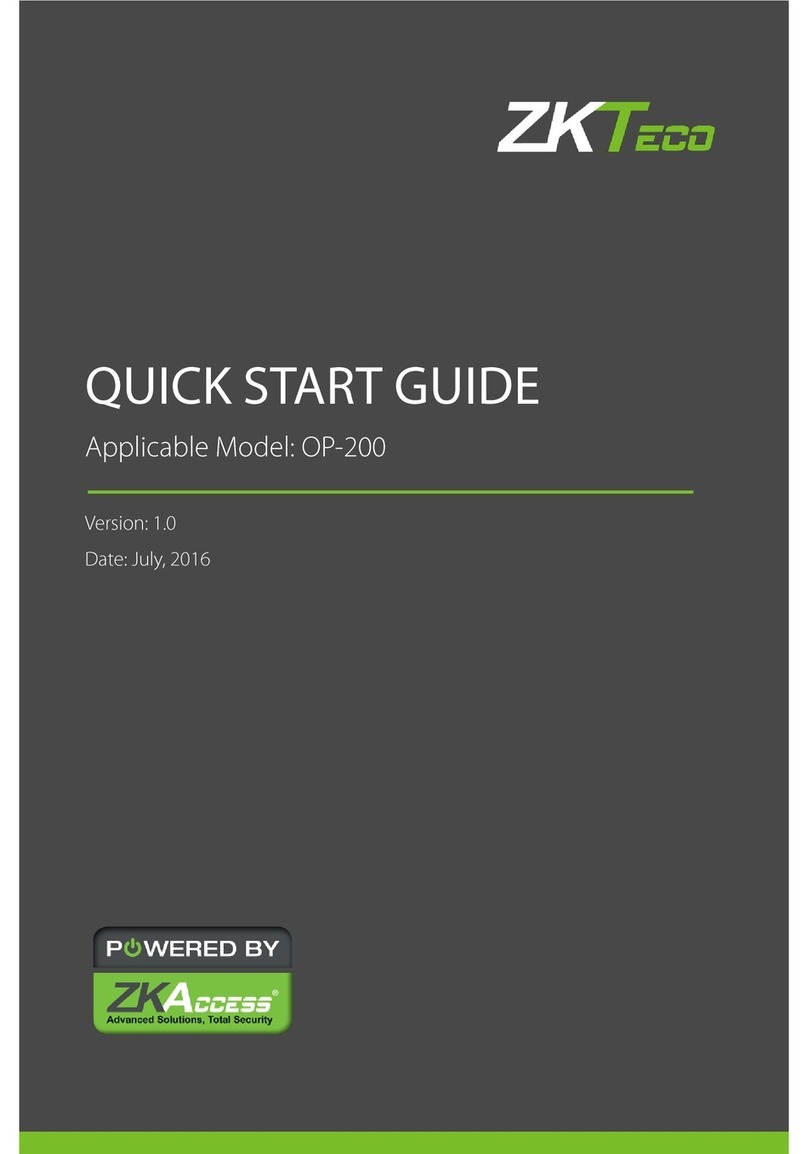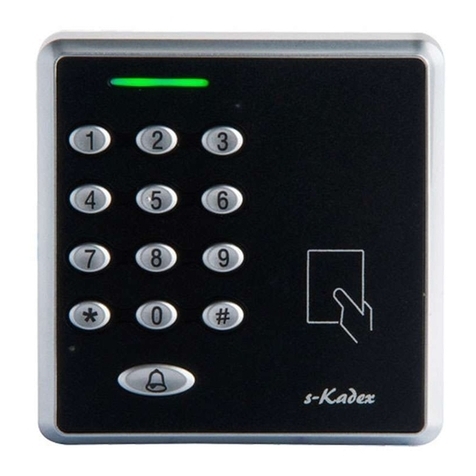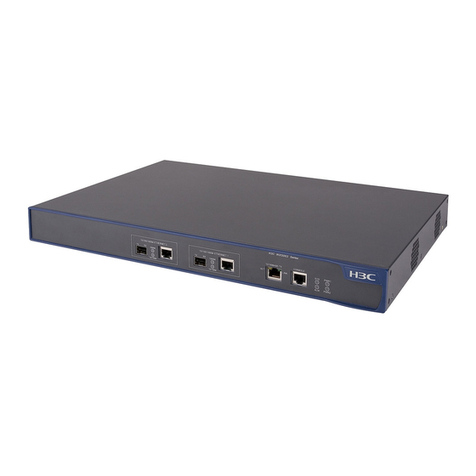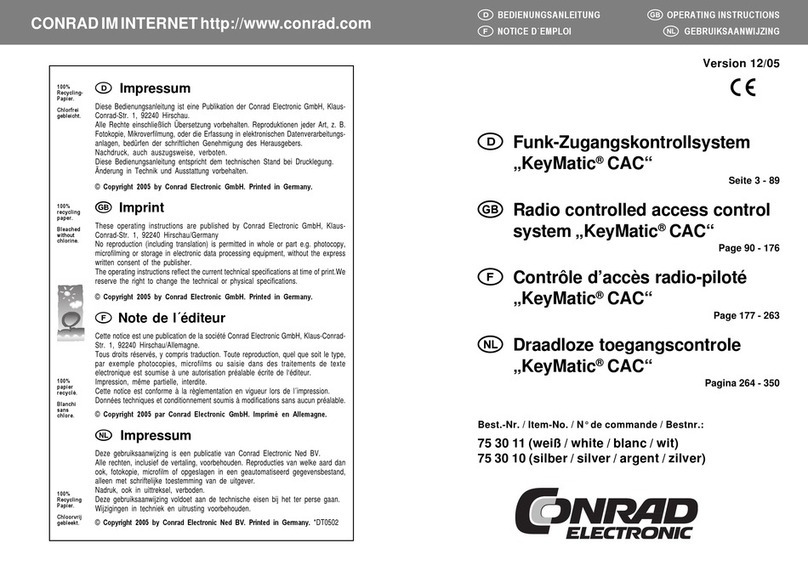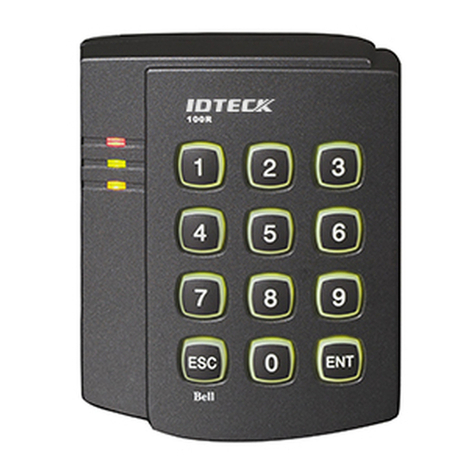
Maximal11FD/Maximal33FD/Maximal55FD/Maximal77FD/Maximal75FD Access Power Controllers (PTC) - 4 -
2. Connect unswitched AC power (120VAC 60Hz) to terminals marked [L, N] (Fig. 3, pg. 8).Use14AWGor
larger for all power connections. Secure green wire lead to earth ground.
Keep power-limited wiring separate from non power-limited wiring. Minimum 0.25” spacing must be provided (Fig. 3, pg. 8).
CAUTION: Do not touch exposed metal parts. Shut branch circuit power before installing or servicing equipment.
There are no user serviceable parts inside. Refer installation and servicing to qualified service personnel.
3. Select desired DC output voltage by setting SW1 to the appropriate position on the power supply board (Maximal11FD
and Maximal33FD), (Fig. 1, pg. 7). Maximal55FD power supply is factory set at 12VDC. Maximal77FD power supply is
factory set at 24VDC. Maximal75FD consists of one (1) power supply board that is factory set at 12VDC, and one (1)
power supply board that is factory set at 24VDC.
4. Measure the output voltage of the unit before connecting any devices to ensure proper operation.
Improper or high voltage will damage these devices.
5. Output options (Fig. 2, pg. 7):
Theunitwillprovideeithersixteen(16)switchedpoweroutputs,sixteen(16)dryform“C”outputs,orany
combinationofbothswitchedpowerandform“C”outputs.
(a) Fail-Safe Switched Power outputs:
For Fail-Safe operation connect the positive (+) input of the access control devices to terminal marked [NC].
Connect the negative (-) input of the access control devices to terminal marked [COM].
(b) Fail-Secure Switched Power outputs:
For Fail-Secure operation connect the positive (+) input of the access control devices to terminal marked [NO].
Connect the negative (-) input of the access control devices to terminal marked [COM].
6. ACM8CB Auxiliary Power outputs (unswitched):
Connect access control devices that require constant power to terminals marked [C] positive (+) and [COM]
negative (-).
eFlow Auxiliary outputs (unswitched):
For auxiliary device connection this output will not be affected by Low Power Disconnect or Fire Alarm Interface.
Connect device to terminals marked [+ AUX -- ] (Fig. 3, pg. 8).
7. Input trigger options (Fig. 2, pg. 7):
(a) Normally Open [NO] input trigger:
Inputs 1-8 are activated by normally open or open collector sink inputs. Connect access control panel outputs,
keypads,pushbuttons,REXPIRs,etc.toterminalsmarked[IN]and[GND].
(b) Open Collector Sink inputs:
Connect the access control panel open collector sink positive (+) to terminals marked [IN] and the negative (-)
toterminalsmarked[GND].
8. ACM8CB Fire Alarm Interface options (Figs. 5-9, pg. 10):
A normally closed [NC] or normally open [NO] input trigger from a fire alarm control panel or a polarity reversal
input from an FACP signaling circuit will affect selected outputs. To enable FACP Disconnect for an output,
open the corresponding switch(es) [SW1-SW8] on each ACM8CB board. To disable FACP disconnect for an
output, close the corresponding switch(es) [SW1-SW8] on each ACM8CB board.
(a) Normally Open [NO] input:
For non-latching hook-up refer to (Fig. 6, pg. 10). For latching hook-up refer to (Fig. 7, pg. 10).
(b) Normally Closed [NC] input:
For non-latching hook-up refer to (Fig. 8, pg. 10). For latching hook-up refer to (Fig. 9, pg. 10).
(c) FACP Signaling Circuit input trigger:
Connect the positive (+) and negative (-) from the FACP signaling circuit output to the terminals marked
[+ INP -]. Connect the FACP EOL to the terminals marked [+ RET -] (polarity is referenced in an alarm
condition). Jumper J3 must be cut (Fig. 5, pg. 10).
9. FACP Dry form “C” output (not evaluated by UL) (Fig. 2a, pg. 7):
FACPform“C”contactscanbeusetotriggerreportingorsignalingdevices.Thesecontactswitch
upon a fire alarm input trigger to the ACM8CB boards.
10. Stand-by Battery Connections (Figs. 3, pg. 8):
For U.S. Access Control applications batteries are optional. Batteries are required for Canadian installations
(ULC-S319). When batteries are not used, a loss of AC will result in the loss of output voltage. When the use of
stand-by batteries is desired, they must be lead acid or gel type.
Connect battery to terminals marked [-- BAT + ] (Fig. 3, pg. 8). Use two (2) 12VDC batteries connected in series for
24VDC operation (battery leads included). Use batteries - Casil CL1270 (12V/7AH), CL12120 (12V/12AH),
CL12400 (12V/40AH), CL12650 (12V/65AH) batteries or UL recognized BAZR2 and BAZR8 batteries of
an appropriate rating.
11. Battery and AC Supervision outputs (Fig. 3, pg. 8):
It is required to connect supervisory trouble reporting devices to outputs marked [AC Fail, BAT Fail] supervisory
relayoutputsmarked[NC,C,NO]toappropriatevisualnotificationdevices.Use22AWGto18AWGfor
ACFail&Low/NoBatteryreporting.
12. To delay AC reporting for 2 hrs., set dip switch [AC Delay] to OFF position (Fig. 3, pg. 8).
To delay AC reporting for 1 min., set dip switch [AC Delay] to ON position (Fig. 3, pg. 8).
